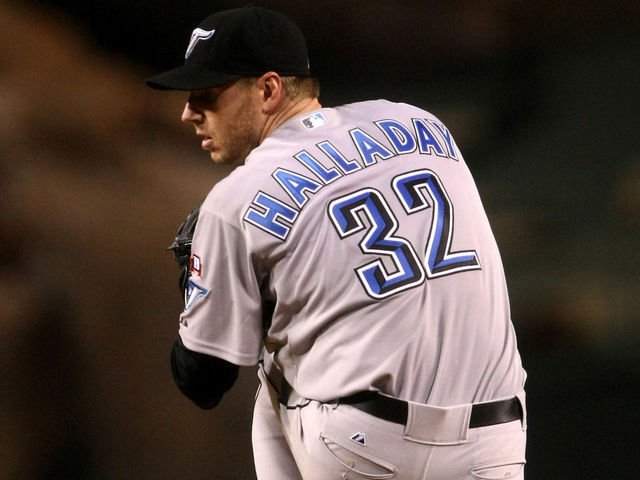Blue Jays
TRENDING: The Blue Jays legend went from zero to hero following the team’s “worst season since 2000”.

When discussing the late and great Roy Halladay, it’s essential to recognize him as one of the Blue Jays’ all-time best players, a contender for the title of the team’s greatest pitcher alongside Dave Steib. However, delving into Halladay’s early years in Toronto reveals an unexpected distinction. According to B/R Walk-Off, he holds the dubious honor of having the worst individual season by a Blue Jays player since 2000, boasting a -2.8 WAR.
Surprisingly, Halladay’s -2.8 WAR ranks as the third-worst overall among the 30 players listed by B/R Walk-Off, which features a selection from every Major League team. This revelation adds an element of surprise, given Halladay’s status as one of the most prominent names on the list and his subsequent stellar career.
Halladay’s initial foray into the Majors showcased significant promise, highlighted by coming within one out of a no-hitter in only his second start at the end of the 1998 season. The following year marked his first extended period in the big leagues, amassing an 8-7 record in 18 starts and 36 overall appearances.
Things begin to deviate.
The journey for the 1995 17th overall draft pick had its share of ups and downs. In his early years, there were signs of promise as he posted a 3.92 ERA, but challenges emerged, evident in a 5.36 FIP and 1.574 WHIP. However, the real struggle unfolded during the 2000 season.

Roy Halladay faced a nightmarish campaign, plagued by a staggering 10.65 ERA, a 6.47 FIP, and a 2.202 WHIP—all marking career-worst performances. ESPN’s Sam Miller notes that this season represented the lowest point in Major League history for a pitcher throwing at least 50 innings.
In an effort to rebuild, Halladay began the 2001 season in Single-A, focusing on rebuilding his confidence and refining his game with pitching coach Mel Queen. Queen, known for his no-nonsense approach, recognized that Halladay was overly reliant on arm strength. With the guidance of Queen and even consulting a sports psychologist, they worked on improving his pitching technique and expanding his repertoire.
Under Queen’s mentorship, Halladay started making strides in the minor leagues, eventually making his return to the Majors later that year. The transformation was evident as he went 5-3 in 16 starts (plus one bullpen appearance), achieving a 3.16 ERA, a 2.34 FIP, and a 1.158 WHIP—a testament to the resilience and dedication that would define Halladay’s remarkable career resurgence.
Establishing a path to the Hall of Fame
The turning point in Roy Halladay’s career came in 2002 when he earned his first-ever All-Star selection. The following year marked a pinnacle moment as he secured his initial Cy Young Award, eventually winning a second one. From that point on, Halladay’s legacy became an integral part of baseball history.
While it is regrettable that Halladay did not conclude his career with the Toronto Blue Jays, the decision to trade him to the Philadelphia Phillies after the 2009 season was driven by a combination of the Blue Jays’ rebuilding efforts and the desire to provide him with the opportunity to compete for a World Series title.

Although Halladay fell short of winning a World Series, he made a significant impact on the postseason stage. In 2010, he achieved a historic feat by pitching just the second-ever postseason no-hitter, a remarkable accomplishment in his inaugural playoff appearance. Notably, this impressive performance came against the Cincinnati Reds, the National League’s best offense that year.
Despite not achieving the ultimate championship, Halladay’s contributions to the game were undeniable. The two-time MLB wins leader ultimately signed a one-day contract to retire as a Toronto Blue Jay, and following his unfortunate passing, he was posthumously elected into the Baseball Hall of Fame in his first year of eligibility, receiving more than 85 percent of the votes. His impact on the sport and his remarkable journey have left an indelible mark on the baseball community.
Roy Halladay is remembered for many qualities, including being durable, hard-working, and supremely talented. However, one of his defining characteristics was his toughness—a resilient individual who showcased superior mental fortitude, exemplified by his remarkable comeback from struggles in the 2000 season.
Halladay’s journey stands as a testament to the heights people can reach when they wholeheartedly commit their heart, mind, and soul to achieving their goals. His enduring legacy continues to resonate, serving as an inspiration for Blue Jays fans, the people of Toronto, and all those involved in the world of baseball. Though sorely missed, Roy Halladay’s impact will never be forgotten, leaving an indelible mark on the hearts and minds of those who admire his tenacity, dedication, and the enduring spirit he brought to the game.
-

 NHL2 months ago
NHL2 months agoXavier Bourgault is recalled by the Oilers despite an awful season in the AHL.
-

 Kentucky Wildcats3 months ago
Kentucky Wildcats3 months agoMark Pope Set to Get His First Kentucky Commitment From Elite Passing Big
-

 LSU3 months ago
LSU3 months agoSAD NEWS: NCAA transfer portal results in the loss of LSU women’s basketball team’s freshman point guard.
-

 Toronto maple leafs2 months ago
Toronto maple leafs2 months agoSAD NEWS: Following his brother’s overdose death, former Toronto Maple Leaf Jason Spezza expressed his heartbreak.
-

 Toronto maple leafs3 weeks ago
Toronto maple leafs3 weeks agoGOOD NEWS: Leafs super star Auston Matthews ties the knot with his longtime girlfriend Emily Ruttledge.
-

 Kentucky Wildcats3 months ago
Kentucky Wildcats3 months agoFollowing Kentucky’s hiring of Mark Pope, Jeff Sheppard provides an update on Reed Sheppard.
-

 Blog2 weeks ago
Blog2 weeks agoBERICHT: Leeds United hat bereits Forderungen für Max Wober gestellt, Transfer wird nun diskutiert
-

 Toronto maple leafs4 months ago
Toronto maple leafs4 months agoJUST IN: Player Safety announces supplemental discipline for Leafs defenseman Jake McCabe












